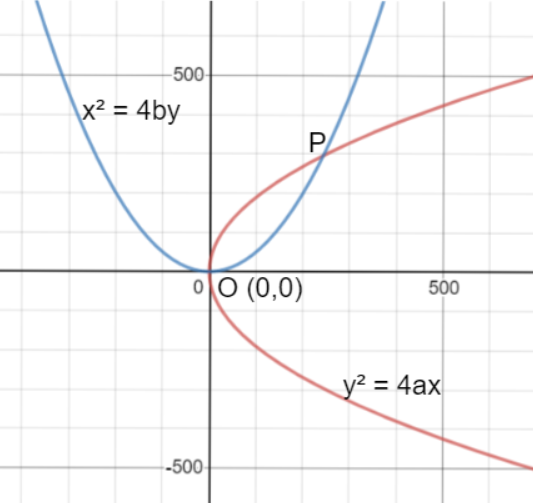Question
Question: Prove that the two parabolas \( {y^2} = 4ax \) and \( {x^2} = 4by \) intersect (other than the origi...
Prove that the two parabolas y2=4ax and x2=4by intersect (other than the origin) at an angle of tan−12a32+b323a31b31.

Solution
Hint: Here, we will proceed by firstly finding the points of intersection of the given parabolas and then we will find the slopes of tangent of these two curves at the intersection point other than origin and then apply the formula tanθ=1+m1m2m2−m1 .
Complete step-by-step answer:
Equations of the given parabolas are y2=4ax →(1) and x2=4by →(2)
Equation (2) can be rewritten as y=4bx2 →(3)
By substituting the value of y from equation (3) in equation (1), we get
⇒(4bx2)2=4ax ⇒16b2x4=4ax
By cross multiplying the above equation, we get
⇒x4=(4ax)(16b2) ⇒x4=64ab2x ⇒x4−64ab2x=0
By taking x common from the LHS of the above equation, we get
⇒x(x3−64ab2)=0
Either x=0 or x3−64ab2=0 ⇒x3=64ab2 ⇒x=(64ab2)31=(64)31(a)31(b2)31 ⇒x=4a31b32
By putting x = 0 in equation (3), we get
y=4b0=0
By putting x=4a31b32 in equation (3), we get
So, the points of intersection of the given parabolas are O(0,0) and P 4a31b32,4a32b31 .
As we know that the slope of the tangent to any curve is given by dxdy
By differentiating equation (1) on both sides with respect to x, we have
⇒dxd(y2)=dxd(4ax) ⇒2ydxdy=4adxdx
By taking 2y from the LHS to the RHS of the above equation, we get
⇒dxdy=2y4a ⇒dxdy=y2a
Slope of the tangent to the parabola y2=4ax at point P 4a31b32,4a32b31 is given by
⇒m1=4a32b312a=2b31a1−32=2b31a33−2 ⇒m1=2b31a31
By differentiating equation (2) on both sides with respect to x, we have
⇒dxd(x2)=dxd(4by) ⇒2xdxdx=4bdxdy ⇒dxdy=4b2x ⇒dxdy=2bx
Slope of the tangent to the parabola x2=4by at point P 4a31b32,4a32b31 is given by
Also, we know that the angle between any two curves having slopes of their tangents as m1 and m2 respectively at a point is given by
tanθ=1+m1m2m2−m1 where θ is the angle between the curves
By putting m1=2b31a31 and m2=b312a31 in the above formula, we get
⇒tanθ=1+2b31a31b312a31b312a31−2b31a31
By taking 2b31 as the LCM of the terms given in the numerator of the RHS of the above equation, we get
⇒tanθ=1+2b31b312a31a312b314a31−a31 ⇒tanθ=1+b32a322b313a31
By taking b32 as the LCM of the terms given in the denominator of the RHS of the above equation, we get
⇒tanθ=b32b32+a322b313a31 ⇒tanθ=2b31b32+a32b323a31 ⇒tanθ=2b32+a323b32b3−1a31 ⇒tanθ=2b32+a323b32−31a31 ⇒tanθ=2b32+a323a31b31
Taking inverse tangent trigonometric function on both sides of the above equation, we get
⇒tan−1(tanθ)=tan−12b32+a323a31b31
Using the formula tan−1(tanθ)=θ in the above equation, we get
⇒θ=tan−12b32+a323a31b31 where θ represents the angle between the given parabolas y2=4ax and x2=4by at a point P 4a31b32,4a32b31 where these two intersect (other than the origin).
Note- The point of intersection between any two curves can be found easily by solving for the values of x and y which will satisfy the equations of both the curves. Also, the slope of the tangent to any curve at a point P ( x1,y1 ) is evaluated by simply finding out dxdy and then putting x = x1 and y = y1 in the expression obtained.
